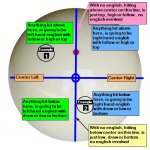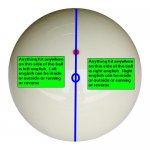It's very confusing to read some of these threads where people describe using top english and bottom english or even center english
Here's a example taken from a thread on the 1st page.
I have never in my life heard top (follow) or bottom (draw) used with english attached to them too, until I came to these forums.
English to me, is very simple. It is used to describe side spin. Meaning that anything hit a millimeter to the left or right of center ball, is going to be english. It will be left or right english.
Additionally, left or right english can be described with the terms, inside or outside. Inside or outside is determined by where the cueball is, in relation to where ever it's going to hit, whether it be just a rail or a object ball. Inside can also be described as reverse and outside can be described as running. Confused? I'll summarize at the bottom of the cueball pic.
Hopefully the picture below helps describing what I am saying.

If one was to describe Example 1. They would one of the following....
I hit it with high left
I hit it with top left
I hit it with left follow
Depending on the placement of the balls, they could substitute left with either inside (reverse) or outside (running) and say this.....
I hit it with high inside/outside
I hit it with top inside/outside
I hit it with inside/outside follow
Now if they wanted to be more specific, which is very helpful, they would include a common reference of measurement, "a tip" In all the examples above, if a person wanted to describe exactly what they used, they would inject the number of tips to indicate exactly where to hit the cueball.
In the example, one could say
I hit it with 2 tips of top and 2 tips of left (or inside/outside or running or reverse)
I hit it with 2 tips of follow and 2 tips of left (or inside/outside or running or reverse)
I hit it with I hit it with 2 tips of high and 2 tips of left (or inside/outside or running or reverse)
SUMMARY:
English is only used to describe left or right of the center of the cueball. It is NOT used to describe hitting above or below the center of the cueball. You don't say "I hit it with top english" or "I hit it with bottom english"

Left or Right english can also be described as inside or outside english.
Inside or outside english can also be described as running or reverse english.
In MOST cases, Inside english is reverse. In MOST cases outside english is running.
When it is not, is pictured in the example below.
Inside or Reverse english means the cueball is going to die or shorten up after it hits the rail
Outside or running english means the cueball is going to haul ass or lengthen after it hits the rail.
Final Summary!
English is left or right, English is inside or outside, English is running or reverse.
Left can be inside or outside
Left can be running or reverse
Right can be inside or outside
Right can be running or reverse
Inside can also be described as reverse
Outside can also be describe as running
I got to go to work.. so you guys can take it from here.
Here's a example taken from a thread on the 1st page.
Example 1 said:So if you play a one rail kick shot with bottom English and hit the OB full, the cue ball stops as if you hit it with no rail bottom. I know it works but don't quite understand why. Seems like the English would tend to reverse after hitting a rail or at least cancel out.
Example 2 said:So it doesn't really retain any back spin, just skid? Would you get the same skid with center English?
I have never in my life heard top (follow) or bottom (draw) used with english attached to them too, until I came to these forums.
English to me, is very simple. It is used to describe side spin. Meaning that anything hit a millimeter to the left or right of center ball, is going to be english. It will be left or right english.
Additionally, left or right english can be described with the terms, inside or outside. Inside or outside is determined by where the cueball is, in relation to where ever it's going to hit, whether it be just a rail or a object ball. Inside can also be described as reverse and outside can be described as running. Confused? I'll summarize at the bottom of the cueball pic.
Hopefully the picture below helps describing what I am saying.

If one was to describe Example 1. They would one of the following....
I hit it with high left
I hit it with top left
I hit it with left follow
Depending on the placement of the balls, they could substitute left with either inside (reverse) or outside (running) and say this.....
I hit it with high inside/outside
I hit it with top inside/outside
I hit it with inside/outside follow
Now if they wanted to be more specific, which is very helpful, they would include a common reference of measurement, "a tip" In all the examples above, if a person wanted to describe exactly what they used, they would inject the number of tips to indicate exactly where to hit the cueball.
In the example, one could say
I hit it with 2 tips of top and 2 tips of left (or inside/outside or running or reverse)
I hit it with 2 tips of follow and 2 tips of left (or inside/outside or running or reverse)
I hit it with I hit it with 2 tips of high and 2 tips of left (or inside/outside or running or reverse)
SUMMARY:
English is only used to describe left or right of the center of the cueball. It is NOT used to describe hitting above or below the center of the cueball. You don't say "I hit it with top english" or "I hit it with bottom english"

Left or Right english can also be described as inside or outside english.
Inside or outside english can also be described as running or reverse english.
In MOST cases, Inside english is reverse. In MOST cases outside english is running.
When it is not, is pictured in the example below.
Inside or Reverse english means the cueball is going to die or shorten up after it hits the rail
Outside or running english means the cueball is going to haul ass or lengthen after it hits the rail.
Final Summary!
English is left or right, English is inside or outside, English is running or reverse.
Left can be inside or outside
Left can be running or reverse
Right can be inside or outside
Right can be running or reverse
Inside can also be described as reverse
Outside can also be describe as running
I got to go to work.. so you guys can take it from here.
Last edited: